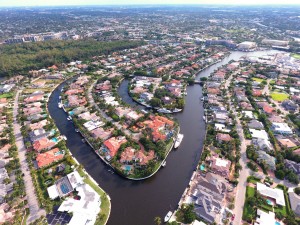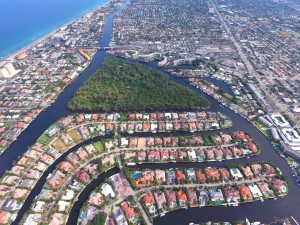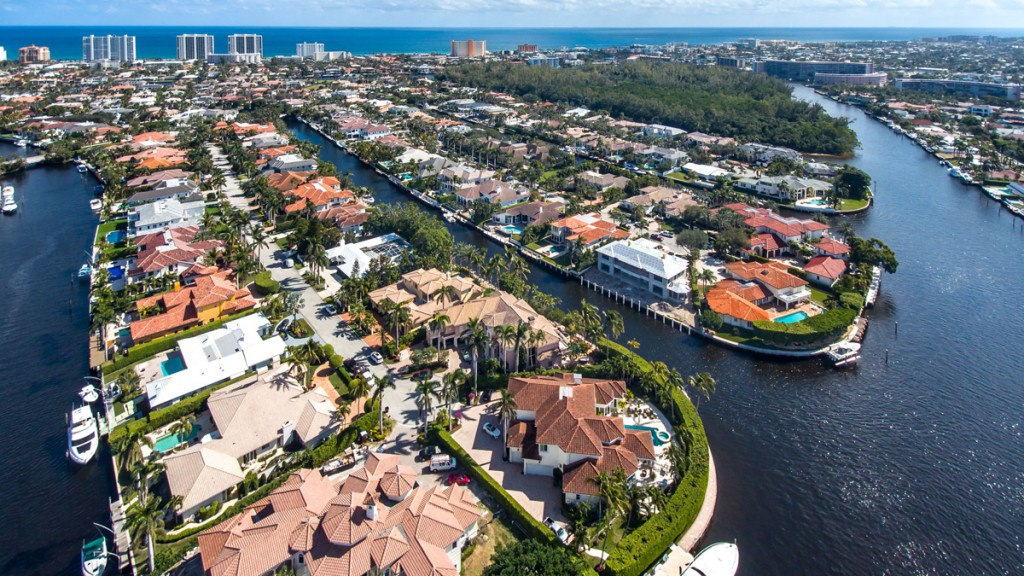Set Sail Into South Florida History
 Sparkling canals may feel like a luxury reserved for the fortunate few—but their presence in South Florida is more than just aesthetic. These waterways, often seen as idyllic backyards for waterfront homes and havens for yachts, began with a much more utilitarian purpose. Before they became the backdrop for sun-drenched afternoons and Instagram-worthy boat days, canals were carved through the land as vital trade routes designed to support commerce, transportation, and expansion.
Sparkling canals may feel like a luxury reserved for the fortunate few—but their presence in South Florida is more than just aesthetic. These waterways, often seen as idyllic backyards for waterfront homes and havens for yachts, began with a much more utilitarian purpose. Before they became the backdrop for sun-drenched afternoons and Instagram-worthy boat days, canals were carved through the land as vital trade routes designed to support commerce, transportation, and expansion.
What was once a passage for pioneers and merchant ships has evolved into a defining feature of South Florida’s luxury lifestyle. The very channels that carried goods and people now carry leisure, culture, and community—connecting the past to the present in every tide.
A Journey Through Time: How Canals Shaped South Florida
The Roots of America’s Waterways and Their Lasting Impact
Long before yachts and pleasure cruisers dotted Florida’s horizon, canals were the arteries of a growing nation. Between 1790 and 1855, the United States experienced a boom in canal construction, a period historians now call the “Canal Age.” These man-made channels were engineered to link key inland cities with major ports, allowing faster and more efficient transport of goods, people, and raw materials.
This explosion of infrastructure changed the economic landscape of the country. In particular, the development of canals between the Great Lakes and urban centers like New York City helped fuel a dramatic expansion of trade and industry. For Florida, which was still largely undeveloped swampland at the time, the canal movement laid the groundwork for future growth. As canals continued to spread, their impact reached far beyond industry—they forged cultural connections, encouraged migration, and shaped the growth of cities across the American South.
The Rise of the Intracoastal Waterway
Connecting Coastlines: From Boston to the Gulf of Mexico
Few man-made water systems have had the enduring influence of the Intracoastal Waterway. Stretching more than 3,000 miles from Boston to Key West and wrapping around the Gulf Coast to Texas, this semi-protected water route was designed to offer a safer alternative to the open ocean—especially during wartime or severe weather. Its network of natural inlets, bays, rivers, and human-made canals formed a critical corridor for commerce and military navigation.
Boca Raton’s place within this maritime highway is both strategic and scenic. Situated along the Florida stretch of the Intracoastal, the city became a pivotal stop for shipping and, later, a prized destination for recreational boaters and yacht owners. These waterways made South Florida more accessible than ever before, allowing development to extend well beyond the shoreline. Communities sprang up along the canals, shaped by the presence of navigable water and the promise of maritime mobility.
Over time, what started as infrastructure to support trade and transportation became the foundation of South Florida’s coastal identity. Today, the Intracoastal Waterway continues to influence how cities grow, how people connect, and how the region presents itself to the world—anchored in history, but driven by lifestyle.

Engineering for the Ages: What Makes These Canals Unique
Built for Function, Perfected for Leisure
The canals that wind through South Florida today weren’t designed with luxury in mind—but their scale and structure make them remarkably well-suited for it. Built to accommodate sizable trade vessels and naval craft, these inland waterways had to meet specific engineering standards. Most canals were constructed to be at least 12 feet deep and 150 feet wide, allowing them to handle large ships that couldn’t access shallower coastal areas.
These specifications, born from necessity, have become a cornerstone of South Florida’s appeal to modern yacht owners. The same dimensions that once allowed for the flow of goods now welcome superyachts, sportfishers, and cruisers of all sizes.
This infrastructure has deeply influenced urban planning and real estate development. Cities like Boca Raton and Fort Lauderdale—often referred to as the “Venice of America”—have expanded along the canals, integrating them into the design of entire neighborhoods. Waterfront properties boast private docks, direct access to the Intracoastal, and scenic canal views that add both aesthetic and financial value to the region’s real estate market. What began as practical engineering has evolved into the framework for South Florida’s most coveted lifestyles.
From Pirates to Pioneers: Colorful Stories from Canal History
Legends Lurk Beneath the Surface
Beneath the surface of South Florida’s calm, glimmering waters lies a past filled with mystery, danger, and lore. Long before the canals were carved, the region’s natural inlets and lakes drew attention for reasons far beyond trade.
One enduring legend places Black Beard, the infamous pirate, in what is now Lake Boca Raton. Though the lake lacked man-made canals at the time, its naturally deep basin offered an ideal hideout—shielded from the view of enemy ships and naval patrols. While tales of buried treasure remain unconfirmed, stories like these hint at the strategic importance of South Florida’s waterways even in the lawless days of high-seas piracy.
Fast forward to the 20th century, and the stakes were no less perilous. During World War II, the Intracoastal Waterway played a critical role in coastal defense and transport. German U-boats prowled the Atlantic, targeting merchant ships along the East Coast. The inland canals provided a safer, concealed route for U.S. vessels transporting supplies and personnel, shielding them from detection and attack. These channels became lifelines—protecting commerce and contributing to the Allied war effort right from Florida’s shores.
Canals Today: South Florida’s Luxury Lifestyle Backbone
Where History Meets High-End Living
Today, South Florida’s canals have fully transitioned from utilitarian pathways to lifestyle icons. They are the veins through which a modern coastal culture flows—connecting communities, hosting recreation, and anchoring the region’s reputation as a world-class yachting destination.
Now lined with multi-million-dollar estates, lush landscaping, and sleek docks, these canals serve as both private escapes and social thoroughfares. Weekend boaters drift past historic neighborhoods, luxury high-rises, and boutique hotels, all while enjoying the relaxed, sun-soaked rhythm that defines the area. Instagram-worthy views, sunset cruises, and waterfront dining are daily experiences rather than special occasions.
Beyond leisure, these waterways continue to unite communities. Canalfront parks, public docks, and boating events offer shared spaces where residents and visitors can connect. The draw is more than scenic—it’s social and deeply embedded in the identity of South Florida living.
For real estate buyers, especially those seeking the boating lifestyle, canal access has become a must-have feature. Properties with direct Intracoastal access not only command a premium but also serve as status symbols and lifestyle enablers. Whether you’re a weekend sailor or the owner of a 200-foot yacht, South Florida’s canal system still offers what it always has—access, adventure, and a gateway to something greater.
Why the Canal System Still Matters
An Enduring Legacy Beneath the Surface
While South Florida’s canals are now synonymous with luxury living and leisure, their functional importance has never disappeared. These waterways continue to play a quiet but vital role in the region’s economy, environment, and identity.
From an economic standpoint, the canal system supports a thriving maritime industry. Yacht maintenance, boat sales, charters, marinas, waterfront construction, and tourism-related services contribute significantly to local employment and business development. The ability to host large vessels directly inland gives South Florida a competitive edge in both domestic and international yachting markets.
Beyond economics, the canals also hold environmental and engineering value. They help manage stormwater and flooding, especially during hurricane season, by providing drainage and overflow capacity for heavy rains and storm surges. The intricate network of waterways—when maintained properly—plays a supporting role in regional resilience planning, especially as sea levels rise and climate considerations become increasingly urgent.
Culturally and historically, these canals serve as living monuments to South Florida’s evolution. They represent a rare blend of human ingenuity and natural beauty—a man-made intervention that didn’t just shape the land but helped shape the people who live along its banks. The canal system connects generations, from pioneers and war-era sailors to modern families and waterfront entrepreneurs. It’s not just infrastructure—it’s heritage.
From Commerce to Culture
Honoring the Past, Embracing the Present
From their earliest days as arteries of trade to their modern role as leisure-laced lifelines, South Florida’s canals are a testament to transformation. They reflect the region’s journey from rugged frontier to luxurious retreat, revealing how much can change when engineering meets vision—and how much endures.
These waterways remind us that progress isn’t always about replacement; sometimes, it’s about reimagining what’s already there. The same canals that once carried cargo now carry memories. They ferry families to ocean adventures, frame backyard barbecues, and host countless sunset reflections.
Whether you’re cruising through Boca Raton’s tranquil stretches or watching a megayacht glide past your waterfront home, these canals offer more than a route—they offer perspective. A link to the past, a pathway to the present, and a promise for the future.
So next time you admire a canal-side view, remember: you’re not just seeing water. You’re witnessing a legacy.


